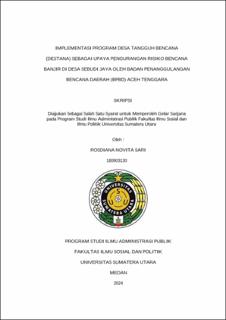| dc.contributor.advisor | Rangkuti, Zoraya Alfathin | |
| dc.contributor.author | Sari, Rosdiana Novita | |
| dc.date.accessioned | 2024-05-28T03:58:01Z | |
| dc.date.available | 2024-05-28T03:58:01Z | |
| dc.date.issued | 2024 | |
| dc.identifier.uri | https://repositori.usu.ac.id/handle/123456789/93466 | |
| dc.description.abstract | Disasters are a serious problem and are prone to occur in Indonesia. The impact of losses is so great that the disaster management paradigm focuses on reducing disaster risk, thus the Head of BNPB Regulation Number 1 of 2012 was issued concerning the Implementation of the Disaster Resilient Village Program as a program implemented by the government and/or regional government in an effort to reduce community-based disaster risk. Southeast Aceh Regency has a high risk of disaster and is also implementing this program. The researcher attempted to outline and describe the research problem so that the researcher conducted research with the title "Implementation of the Disaster Resilient Village Program (Destana) as an Effort to Reduce Flood Disaster Risk in Sebudi Jaya Village by the Southeast Aceh Regional Disaster Management Agency (BPBD)"
This study uses a qualitative method. Data collection used by researchers was interview, observation and documentation techniques. The data obtained were analyzed using the implementation theory proposed by Van Meter and Van Horn.
The research results show that the implementation of the disaster resilient village Program as an effort to contain disaster risk has not been optimal. Sebudi Jaya as one of the disaster resilient villages, if analyzed using the Van Meter and Van Horn implementation models on policy standards and targets guided by central regulations, however at the regional level there is a weak spirit of prioritizing the implementation of disaster risk reduction programs is proven by the absence of programs at the regional level in efforts to reduce disaster risk so it is difficult to achieve this indicator, relevant to the resources in the field of prevention and preparedness, BPBD, village government and community are not yet adequate in terms of quality, OPD funds are limited so that the procurement of facilities and infrastructure such as building shelters is also non-existent. The characteristics of implementing agents regarding the bureaucratic structure are not complicated, but the commitment of BPBD, village government and community is not yet optimal. The disposition of the BPBD, Village Government and community response implementers towards the program has not shown support and efforts to reduce disaster risk. This is related to social, economic and political environmental indicators that have not made efforts to support the success of the program. | en_US |
| dc.language.iso | id | en_US |
| dc.publisher | Universitas Sumatera Utara | en_US |
| dc.subject | Implementation | en_US |
| dc.subject | Program | en_US |
| dc.subject | Disaster Resilient Village | en_US |
| dc.subject | Flood Management | en_US |
| dc.subject | Sebudi Jaya Village | en_US |
| dc.subject | SDGs | en_US |
| dc.title | Implementasi Program Desa Tangguh Bencana (DESTANA) sebagai Upaya Pengurangan Risiko Bencana Banjir di Desa Sebudi Jaya oleh Badan Penanggulangan Bencana Daerah (BPBD) Aceh Tenggara | en_US |
| dc.title.alternative | Implementation of The Disaster Resilient Village Program (DESTANA) as An Effort to Reduce Flood Disaster Risk in Sebudi Jaya Village by The Southeast Aceh Regional Disaster Management Agency (BPBD) | en_US |
| dc.type | Thesis | en_US |
| dc.identifier.nim | NIM180903130 | |
| dc.identifier.nidn | NIDN0008029402 | |
| dc.identifier.kodeprodi | KODEPRODI63201#Ilmu Administrasi Publik | |
| dc.description.pages | 208 Pages | en_US |
| dc.description.type | Skripsi Sarjana | en_US |





